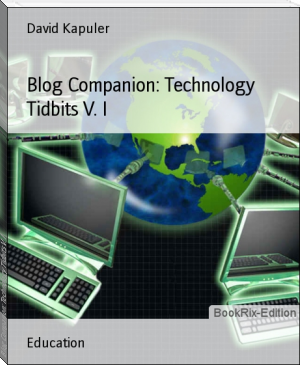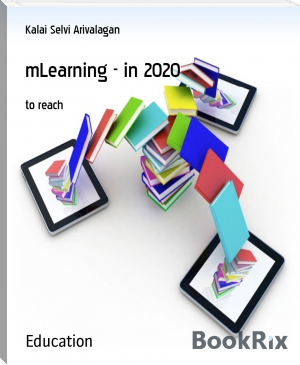INNOVATIONS IN SCIENCE, TECHNOLOGY AND MATHEMATICS EDUCATION IN NIGERIA by Ebele C. Okigbo, Nneka R. Nnorom, Ernest O. Onwukwe (the ebook reader .txt) 📖

- Author: Ebele C. Okigbo, Nneka R. Nnorom, Ernest O. Onwukwe
Book online «INNOVATIONS IN SCIENCE, TECHNOLOGY AND MATHEMATICS EDUCATION IN NIGERIA by Ebele C. Okigbo, Nneka R. Nnorom, Ernest O. Onwukwe (the ebook reader .txt) 📖». Author Ebele C. Okigbo, Nneka R. Nnorom, Ernest O. Onwukwe
Research question
What is the difference in the mean achievement scores of students taught computer studies using CLS and those taught with the CM?
Hypothesis
One null hypothesis was formulated and tested at 0.05 level of significance.
There is no significant difference in the mean achievement scores of students taught computer studies using CLS and those taught using CM.
Method
The design of the study is quasi-experimental, specifically pre-test post-test non-equivalent control group design was used. This design is considered appropriate because research subjects were non-randomized and assigned into experimental and control groups. Thus, intact groups were used. The research was carried out among senior secondary two (SS2) students in Dunukofia Local Government Area of Anambra State (LGA). The population of the study comprised of all the 2017 /2018 computer studies SS2 students in the eight public co-educational secondary schools in the L.G.A.
The sample for the study consists of 201 SS2 students. Multistage sampling procedure was used to compose the sample. First four out of eight public secondary school in the L.G.A were purposively selected because only four schools offer computer studies in external examination. Simple random sampling technique (balloting with replacement) was further used to choose two schools. Two intact classes in each school were randomly assigned to treatment and control groups respectively. Before the treatment commenced, the researchers trained research assistance, developed a lesson plan for both experimental and control group and an instrument titled Computer Studies Achievement Test (CSAT). Research assistance is learners’ regular computer teachers. CSAT is a 50 - item multiple choice questions with four response option A-D. It covers the content of the study which was derived from the theme Basic Computer Operations in SS2, because it is an aspect of the computer studies curriculum that is taught in SS2 during the period of the experiment. Instruments were validated by expertsfrom science education department, measurement and evaluation and one experienced secondary school computer studies teacher. The advice of the experts helped the researchers to modify and select the final instrument used for this study. The reliability of the CSAT was determined using Kuder Richardson Formula 20 and the internal consistency established to be 0.79.
However, the study was carried out by research assistance using the developed lesson plan of the researchers.The study involved two groups of subjects namely; experimental group (CLS group) and the control group. The two groups were taught the same topics using two different strategies (CLS and CM being the control group) respectively. Before the teaching began, test was given to the two groups which served as pretest. At the end of the four weeks teaching, the groups were administered another test which was reshuffled. The reshuffled test became the post-test. The scores from each test were collected and correlated serving as pre and post achievement score. Hence, data collected were analyzed using mean, standard deviation and Analysis of covariance (ANCOVA).
Results
Research Question 1: What are the mean achievement scores of students taught computer studies using competitive strategy and those taught with the conventional method?
Table 1: Mean and standard deviation of students’ achievement scores in computer studies
Pre-test Post-test
From Table 1, the difference in the mean achievement scores of students in the two groups is 5.42. the standard deviation scores in both pretest and post-test scores of students in experimental group are less in each case and therefore more homogeneous than that of those in the control group. The SD post-test reveal that the treatment with CLS was able to bring the participant scores closer than before the treatment.
H01: There is no significant difference in the mean achievement scores of students taught computer studies using competitive strategy and those taught with the conventional method.
Table 2: Analysis of covariance of the mean achievement scores of students taught computer studies using competitive learning strategy and conventional method
Source
Sum of squares
Df
Mean square
F
Sig
Decision
Corrected Model
1137.151
2
568.575
20.382
.000
Intercept
7563.084
1
7563.084
271.121
.000
Pretest
15.844
1
15.844
.568
.452
Group
1136.114
1
1136.114
40.727
.000
S*
Error
5523.337
198
27.896
Total
73999.000
201
Corrected Total
6660.488
200
*Significant at P< 0.05)
The results in Table 2 portrayed that there is a significant difference at 0.05 level of significance in the post-test mean scores of the control and experimental groups. Therefore, the null hypothesis which states that there is no significant difference between the mean achievements scores of students taughtcomputer studies using competitive strategy and those taught using the conventional method is rejected. There is a significant difference between the mean achievement scores of students taught computer studies using competitive strategy and those taught using the conventional method (P<0.05). This means that students taught using competitive learning strategy achieved higher than the students taught using the conventional method.
Discussion
The result revealed that the mean gain of the experimental group is 10.58 and their SD in the pretest and post-test is 9.98 and 10.58 respectively. The control group had a mean achievement scores of students taught computer studies using CLS and those taught with CM is 5.42. To find if the difference in the mean achievement scores between the group was significant or not a Two-way analysis of co-variance was used which showed that a significant main effect for strategy on students’ achievement in computer studies. The findings of this study revealed that CLS is a good strategy that leads to high achievement in computer studies. CLS was more effective because students are more actively involved during instructional process. When students are actively involved, they seemed to understand the concepts better than just listening to lessons only. The findings are in line with other studies whereby experimental group taught with competitive learning strategy achieved significantly better than the control group. Such studies include those of Okereke & Ugwuegbulam (2014), Oloyede, Adebowale & Ojo (2012), Qin, Johnson & Johnson (2005). All these studies showed the superiority of competitive learning strategy over the conventional method of instruction on students’ achievement.
Conclusion
The study concluded that competitive learning strategy is superior to conventional method of instruction in enhancing academic achievement of students in computer studies.
Recommendations
Based on the findings, the study recommended that;
Computer studies teachers should be encouraged to employ competitive strategy during instructions.
Computer studies teachers should be sponsored by their employers to attend seminars, workshops and conferences to update their teaching competencies, knowledge and skills especially in the use of competitive strategy during instruction.
The government, institutions and philanthropists should encourage students at all levels of education to study computer by giving scholarship to the best performed students in computer studies and a way of creating competition for them
References
Chief Examiners Report (2014). West African Senior Secondary Certificate Examination (WASSEC). Awka, Anambra State.
Chief Examiners Report (2015). WASSEC. Awka, Anambra State.
Chief Examiners Report (2016). WASSEC. Awka, Anambra State.
Federal Republic of Nigeria (2013). National policy on education. Lagos: NERDC Press.
Galvin, K. (1996). Co-operative / collaborative learning. Retrieved May 25th, 2018 from http://www.opa.ude/.edu/apa/archieve/newletters/v962/teaching/cooperative.Gsp
Johnson, D. and Johnson, R. (1999). Learning together and alone: cooperative, competitive and individualistic learning. Boston: Allyn and Bacon.
Njoku, Z.C. (2008). Enhancing the relevance of chemistry curriculum delivery using science- technology society. (S.T.S) Approach. J.A Holbook, P.C Eninyeyu. (Eds). Processing of African Regional Conference of International Council of Association for Science Education, 48-54
Nnoli, J.N. and Okafor, C.U. (2017). Enhancing students’ academic achievement and retention of knowledge through the use of chemistry instructional materials: Implication for STEM Education in our society. The Science Teachers Association Nigeria 60th Anniversary Conference Proceedings,
Offiah, F.C. and Okonkwo, C.O. (2011). Cooperative learning strategy and students’ academic achievement in chemistry. UNIZIK Journal of STM Education, 1(2),63-70.
Ogbonne, U.T. and Offorma, G.C. (2013). Effect of collaborative learning method on secondary students’ interest in English tenses. International Journal of Education Research, 12(2), 128-135.
Okeke, C.N.A.(2014). Competitive Learning Style. A seminar paper presented to the Faculty of Education, University of Nigeria, Nsukka.
Okekeokosisi, J.O.C.& Okeke, C.N.A. (2015). The effect of constructivist teaching approach on students’ academic achievement, gender and interest in Junior secondary schools Agricultural science subject. Contemporary Journal of Empirical Research, 15(1),105-125.
Okereke, C. & Ugwuegbulam, C.N. (2014). Effect of competitive learning strategy on Secondary School Students Learning Outcome: Implications for Counselling. International Journal of Academic Research in Progressive Education and Development, 3(2), 137-143.
Okigbo, E.C. & Okekeokosisi, J.O.C. (2016). Effectiveness of constructivist instructional model in enhancing secondary school students’ achievement in computer science. International Journal of Education Science and Public Policy in Africa (IJESPPA), Issue 6, 1-9.
Opera, J.N. (2006). The concept of teaching, instruction and learning. A seminar paper presented to College of Education, Imo State University.
Rohrbeck, C.A., Ginsbury, B., Fontuzzo, J.W., & Miller, W. (2003). Effects of reciprocal peer tutoring on academic achievement and psychologist adjustment: A component analysis. Journal of Educational Psychology, 8(2), 73-77.
EFFECT OF ACTIVITY- BASED LEARNING ON
STUDENTS’ ACHEIVEMENT IN QUADRATIC EQUATIONS
Dr. Blessing C. Anakpua, Chinyere N. Emefo
&
Emmanuel C. Nzeakor
Abstract
This study investigated the effect of Activity- Based Learning (ABL) on students’ achievement in quadratic equations. Two research questions and two hypotheses tested at 0.05 alpha levels guided the study.The study employed pre-test post-test quasi experimental research design. The population of the study consisted of 1603 Senior Secondary two (SSII) students in Onitsha North Local Government of Anambra State. A sample of 177 SSII students in one co-education secondary school randomly selected from four intact classes was used.The instrument for data collection was Quadratic Equations Achievement Test (QEAT) which contained 25 items. The content of the items involved factorization method, completing the square method, quadratic formula method and graphical method. The instrument was face and content validated by three experts. Reliability of the instrument was estimated at 0.71 and 0.89 using split-half reliability method. Data were analyzed using mean, standard deviation and t-test. The result of the study showed that ABL fostered higher achievement in quadratic equations than the conventional method.There is a significant difference between the mean score of mathematics students’ taught quadratic equations with ABL and those taught with conventional method. Also there is no significant difference between the mean achievement scores of male and female students taught quadratic equations using the ABL. It was recommended among others that secondary school mathematics teachers should adopt the use ABL in teaching.
Keywords: Activity - based learning, students’ achievement, quadratic equations.
Introduction
Mathematics is one of the compulsory subjects introduced into Nigerian school curriculum to help in the day-to-day interactions, scientific and technological development and also help in the day-to-day interactions of members of the society. According to Wikipedia (2010), mathematics has so many branches which include arithmetic, algebra, geometry, calculus, statistics topology, mathematical modelling. Algebra which is a branch of mathematics concerned with the study of the rules of operations which include polynomials, equations and algebraic structures and quadratic equation is an aspect of algebra with is a second-degree sentence whose standard form is ax2+bx+c=0, where a, b, c are real numbers and a≠0. The importance of quadratic equation to man cannot be overemphasized because it is use to construct the Holland Tunnel under the Hudson River in New York, radar dishes, reflectors or spotlights, components of microphones and cables of suspension bridges which have the shape of parabolas. Wheeler and Peeples (1986) stipulated that profit and cost functions in business equilibrium, point and Laffer curve in economics, blood velocity and pollution in life sciences and population growth in the social sciences are all models of quadratic functions.
Despite the importance of quadratic equations in the development of science, there are still persistent poor achievement of student in this area. Kieran (2007) posited that quadratic equations so important in the society but studies showed that teaching and learning of quadratic equations are quite scarce in algebra education research. Havi (2014) stated that West Africa Examination Council is worried about the persistent errors in solving quadratic equations among the students. Report from the Institute of Education, University of Cape Coast stated that over 85% of level 100 students of Colleges of Education performed poorly in quadratic equation questions between 2008 and 2016 end of semester examination. The Institute stated that the few students who attempted solving quadratic equation questions had difficulties in identifying constants when the coefficient of x2 is not unity and as well as difficulties in finding the factors of the equation.
Bossè and Nandakumar (2005) indicated that the factoring techniques of solving quadratic equations are problematic for students especially, when the leading coefficient or constant in the quadratic has many pairs
 The desire to acquire knowledge about the surrounding world and human society is quite natural and understandable for a person. Life is so developed that an uneducated person will never occupy a high position in any field. Humanity in its mass, and each person individually, develops objectively, regardless of certain life circumstances and obstacles, but with different intensity. The speed of development depends on the quality of training.
The desire to acquire knowledge about the surrounding world and human society is quite natural and understandable for a person. Life is so developed that an uneducated person will never occupy a high position in any field. Humanity in its mass, and each person individually, develops objectively, regardless of certain life circumstances and obstacles, but with different intensity. The speed of development depends on the quality of training.




Comments (0)